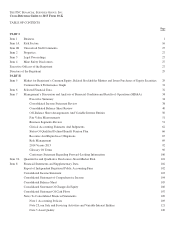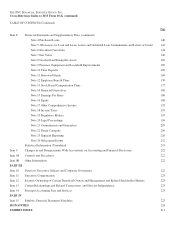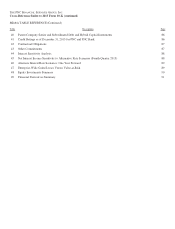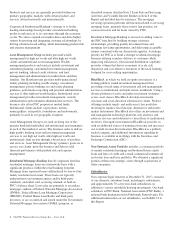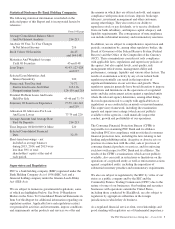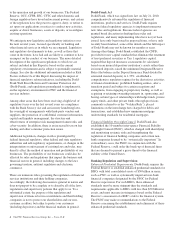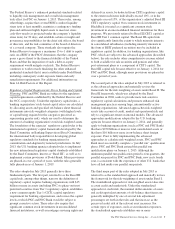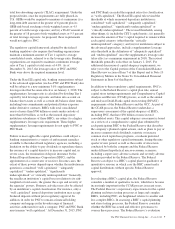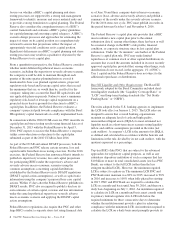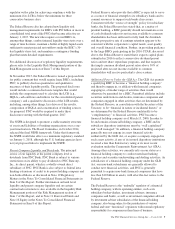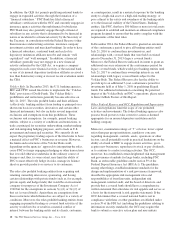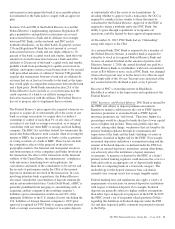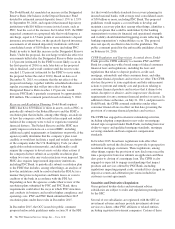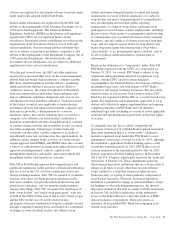PNC Bank 2015 Annual Report Download - page 22
Download and view the complete annual report
Please find page 22 of the 2015 PNC Bank annual report below. You can navigate through the pages in the report by either clicking on the pages listed below, or by using the keyword search tool below to find specific information within the annual report.
to the operation and growth of our businesses. The Federal
Reserve, OCC, CFPB, SEC, CFTC and other domestic and
foreign regulators have broad enforcement powers, and certain
of the regulators have the power to approve, deny, or refuse to
act upon our applications or notices to conduct new activities,
acquire or divest businesses, assets or deposits, or reconfigure
existing operations.
We anticipate new legislative and regulatory initiatives over
the next several years, focused specifically on banking and
other financial services in which we are engaged. Legislative
and regulatory developments to date, as well as those that
come in the future, have had and are likely to continue to have
an impact on the conduct of our business. The more detailed
description of the significant regulations to which we are
subject included in this Report is based on the current
regulatory environment and is subject to potentially material
change. See also the additional information included as Risk
Factors in Item 1A of this Report discussing the impact of
financial regulatory reform initiatives, including the Dodd-
Frank Wall Street Reform and Consumer Protection Act
(Dodd-Frank), and regulations promulgated to implement it,
on the regulatory environment for PNC and the financial
services industry.
Among other areas that have been receiving a high level of
regulatory focus over the last several years are compliance
with the Bank Secrecy Act and anti-money laundering laws,
the oversight of arrangements with third-party vendors and
suppliers, the protection of confidential customer information,
capital and liquidity management, the structure and
effectiveness of enterprise risk management frameworks, and
cyber-security. In addition, there is an increased focus on fair
lending and other consumer protection issues.
Additional legislation, changes in rules promulgated by
federal financial regulators, other federal and state regulatory
authorities and self-regulatory organizations, or changes in the
interpretation or enforcement of existing laws and rules, may
directly affect the method of operation and profitability of our
businesses. The profitability of our businesses could also be
affected by rules and regulations that impact the business and
financial sectors in general, including changes to the laws
governing taxation, antitrust regulation and electronic
commerce.
There are numerous rules governing the regulation of financial
services institutions and their holding companies.
Accordingly, the following discussion is general in nature and
does not purport to be complete or to describe all of the laws,
regulations and supervisory policies that apply to us. To a
substantial extent, the purpose of the regulation and
supervision of financial services institutions and their holding
companies is not to protect our shareholders and our non-
customer creditors, but rather to protect our customers
(including depositors) and the financial markets in general.
Dodd-Frank Act
Dodd-Frank, which was signed into law on July 21, 2010,
comprehensively reformed the regulation of financial
institutions, products and services. Dodd-Frank requires
various federal regulatory agencies to implement numerous
new rules and regulations. Because federal agencies are
granted broad discretion in drafting these rules and
regulations, and many implementing rules have not yet been
issued, have only been issued in proposed form, or have only
recently been finalized, some of the details and the full impact
of Dodd-Frank may not be known for months or years.
Among other things, Dodd-Frank established the CFPB;
provided for new capital standards that eliminate the treatment
of trust preferred securities as Tier 1 regulatory capital;
required that deposit insurance assessments be calculated
based on an insured depository institution’s assets rather than
its insured deposits; raised the minimum Designated Reserve
Ratio (the balance in the Deposit Insurance Fund divided by
estimated insured deposits) to 1.35%; established a
comprehensive regulatory regime for the derivatives activities
of financial institutions; prohibited banking entities, after a
transition period and subject to certain exceptions and
exemptions, from engaging in proprietary trading, as well as
acquiring or retaining ownership interests in, sponsoring, and
having certain types of relationships with hedge funds, private
equity funds, and other private funds (through provisions
commonly referred to as the “Volcker Rule”); placed
limitations on the interchange fees charged for debit card
transactions; and established new minimum mortgage
underwriting standards for residential mortgages.
Financial Stability Oversight Council. Dodd-Frank also
established the 10-member inter-agency Financial Stability
Oversight Council (FSOC), which is charged with identifying
and monitoring systemic risks and strengthening the
regulation of financial holding companies and certain non-
bank companies deemed to be “systemically important.” In
extraordinary cases, the FSOC, in conjunction with the
Federal Reserve, could order the break-up of financial firms
that are deemed to present a grave threat to the financial
stability of the United States.
Banking Regulation and Supervision
Enhanced Prudential Requirements. Dodd-Frank requires the
Federal Reserve to establish enhanced prudential standards for
BHCs with total consolidated assets of $50 billion or more,
such as PNC, as well as systemically important non-bank
financial companies designated by the FSOC for Federal
Reserve supervision. For such BHCs, these enhanced
standards must be more stringent than the standards and
requirements applicable to BHCs with less than $50 billion in
assets, and must increase in stringency based on the Federal
Reserve’s assessment of a BHC’s risk to the financial system.
The FSOC may make recommendations to the Federal
Reserve concerning the establishment and refinement of these
enhanced prudential standards.
4The PNC Financial Services Group, Inc. – Form 10-K


